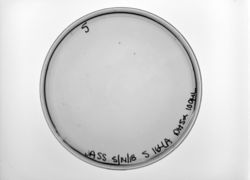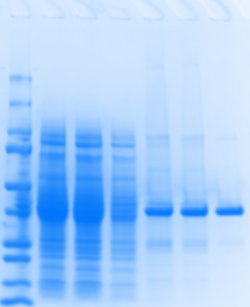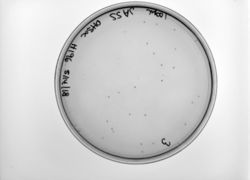User:Jennifer Taylor/Sandbox 8
From Proteopedia
< User:Jennifer Taylor(Difference between revisions)
m |
|||
| (58 intermediate revisions not shown.) | |||
| Line 1: | Line 1: | ||
| - | == | + | <StructureSection load='3szp' size='340' side='right' caption='AphB biological Assembly=''> |
| + | == Instructional Information == | ||
| + | [[Image:JASS S164A 052018.jpg|thumb|left|250px|Figure 1: Bacterial Transformation]] | ||
| + | [[Image:Protein Gel.png|thumb|left|250px|Figure 2: Here is an example of a protein gel. To display a gel, you should be annotate it with size standards and lane numbers.]] | ||
| - | + | '''Adding an uploaded image into your page | |
| + | ''' | ||
| + | '''1.''' To add an image of your experiments, you first need to have an image as a JPG or PNG on your computer | ||
| - | + | '''2.''' In your editing page, insert the following code: | |
| - | == | + | <span style = "background: yellow;"><nowiki>[[</nowiki><span style= "color:black;">Image:</span><span style= "color:blue;">choose a filename.jpg</span><span style= "color:black;">|thumb|left|250px|Figure</span><span style= "color:blue;"> insert figure#: insert your caption</span><nowiki>]]</nowiki></span> |
| - | + | '''Uploading the image from your computer | |
| + | ''' | ||
| - | == | + | <span style = "color: blue;">'''If you are uploading ''after'' adding the code to your page'''</span> |
| - | Each AphB <scene name='78/787198/Aphb_monomer_compact/1'>monomer</scene> comprises an N-terminal <scene name='78/787198/Aphb_monomer_dbd/1'>DNA binding domain</scene> (DBD) and a C-terminal <scene name='78/787198/Aphb_monomer_rd/1'>regulatory domain</scene> (RD). The DBD is connected to the RD via the <scene name='78/787198/Aphb_monomer_lh/3'>linker helix</scene>. AphB subunits are found in two distinct conformations within the tetramer, as determined by the angle between the linker helix and the RD. In the compact form, the RD and linker helix form an angle of 85 degrees, whereas this angle is 150 degrees in the extended form. Interestingly, the LH forms the dimerization interface between one compact and one extended subunit. | + | |
| + | '''1.''' Save your page after editing and scroll to the image name on your page. Click on the link. | ||
| + | |||
| + | '''2.''' An upload image page should appear. | ||
| + | |||
| + | '''3.''' Select the file from your computer that you would like to upload (for example, an annotated gel image or assay figure). | ||
| + | |||
| + | '''4.''' Add a summary if you want to | ||
| + | |||
| + | '''5.''' Licensing: If this is your own image, select:''Own work > "Creative Commons Attribution 3.0'' | ||
| + | |||
| + | '''6.''' Click:''' Upload File | ||
| + | |||
| + | <span style = "color: blue;">'''If you are uploading ''before'' adding the code to your page'''</span> | ||
| + | |||
| + | '''1.''' On the "toolbox" menu at the lower left of the screen, click on <span style="color: blue;"> "Upload File" '''</span> | ||
| + | |||
| + | '''2.''' Next, select the file from your computer that you would like to upload (for example, an annotated gel image or assay figure). | ||
| + | |||
| + | '''3.''' Choose a filename that makes sense. | ||
| + | |||
| + | '''4.''' Write a summary of your image now, or do this later. | ||
| + | |||
| + | '''5.''' Licensing: If this is your own image, select: "Own work" > "Creative Commons Attribution 3.0" | ||
| + | |||
| + | '''6.''' Click:''' Upload File | ||
| + | ''' | ||
| + | You can resize your image (change the "250px" to a larger or smaller pixel count), or set the location to right or center as you wish. | ||
| + | |||
| + | {{clear}} | ||
| + | |||
| + | Any text you type will show around your thumbnail image, unless you type "clear" within double {{ }}. Take a look at my editing page to see exactly what I have done. | ||
| + | |||
| + | ''' Text Formatting | ||
| + | ''' | ||
| + | |||
| + | '''1. ''' To make your text '''bold''' or ''italic'', surround the selected text with 3 or 2 apostrophes (do not use double quotes) on each side, respectively. You can also highlight the text and hit the bold or italics button. | ||
| + | |||
| + | '''2. ''' To make this cool header, start a new line, insert a space, then type your text | ||
| + | |||
| + | |||
| + | '''3.''' To change the color of your text, use the following code: <nowiki><span style="color:blue;"></nowiki><span style="color:blue;">Insert text here</span><nowiki></span></nowiki> Some colors to try: '''<span style = "color: mediumseagreen;">MediumSeaGreen</span>, <span style = "color: slateblue;">SlateBlue</span>, <span style = "color: darkorchid;">DarkOrchid</span>, <span style = "color: tomato;">Tomato</span>, <span style = "color: navy;">Navy</span>, <span style = "color: chartreuse;">Chartreuse</span> or <span style = "color: rebeccapurple;">RebeccaPurple</span>. '''For the full list of color names, see [https://www.w3schools.com/colors/colors_names.asp this page]. | ||
| + | |||
| + | '''4. ''' To add a colored background to your text, use the following code: <nowiki><span style="background:lightgrey;"></nowiki><span style="background:lightgrey;">Insert text here</span><nowiki></span></nowiki>. The same color names as above apply to backgrounds. By combining background and color formatting, <span style="background:forestgreen; color:oldlace">''' you can create text that looks like this '''</span> | ||
| + | |||
| + | <tt>5. For a big "cheat sheet" of formatting, you can click [https://www.wired.com/2010/02/html_cheatsheet/ this link]</tt> | ||
| + | |||
| + | |||
| + | ==Transcription Factor AphB from ''V. cholerae'' (examples of scenes) == | ||
| + | |||
| + | '''Structural highlights''' | ||
| + | Each AphB <scene name='78/787198/Aphb_monomer_compact/1'>monomer</scene> comprises an N-terminal <scene name='78/787198/Aphb_monomer_dbd/1'>DNA binding domain</scene> (DBD) and a C-terminal <scene name='78/787198/Aphb_monomer_rd/1'>regulatory domain</scene> (RD). The DBD is connected to the RD via the <scene name='78/787198/Aphb_monomer_lh/3'>linker helix</scene>. AphB subunits are found in two distinct conformations within the tetramer, as determined by the angle between the linker helix and the RD. In the <scene name='78/787198/Aphb_compact/1'>compact</scene> form, the RD and linker helix form an angle of 85 degrees, whereas this angle is 150 degrees in the extended form. Interestingly, the LH forms the dimerization interface between one compact and one extended subunit. | ||
The tetramer (chains A, B, C and D) can be described as a dimer of dimers. Each of two identical dimers are composed of a compact (A and C) and extended (B and D) monomer. The compact and extended subunits differ from one another in the angle between the linker helix and the RD, which is 85° in the compact subunits and 150° in the extended subunits (Fig. 1A). The conformational variability in the AphB subunits can be attributed to the flexible loop connecting the linker helix to the regulatory domain. | The tetramer (chains A, B, C and D) can be described as a dimer of dimers. Each of two identical dimers are composed of a compact (A and C) and extended (B and D) monomer. The compact and extended subunits differ from one another in the angle between the linker helix and the RD, which is 85° in the compact subunits and 150° in the extended subunits (Fig. 1A). The conformational variability in the AphB subunits can be attributed to the flexible loop connecting the linker helix to the regulatory domain. | ||
| Line 18: | Line 75: | ||
The tetramer assembles via two distinct dimerization interfaces (Fig. 2A). The N‐terminal dimerization interface (1142 Å2) is primarily made up of an antiparallel coiled‐coil of the two linker helices, held together by hydrophobic, polar and ionic interactions (Fig. 2A, left inset). The C‐terminal dimerization interface (1414 Å2) forms between regulatory domains, which pack against each other in a head‐to‐tail manner (Fig. 2A, right inset). To form the AphB tetramer, each compact subunit interacts with the regulatory domain of one extended subunit and with the linker helix of the other extended subunit (Fig. 2A and B). | The tetramer assembles via two distinct dimerization interfaces (Fig. 2A). The N‐terminal dimerization interface (1142 Å2) is primarily made up of an antiparallel coiled‐coil of the two linker helices, held together by hydrophobic, polar and ionic interactions (Fig. 2A, left inset). The C‐terminal dimerization interface (1414 Å2) forms between regulatory domains, which pack against each other in a head‐to‐tail manner (Fig. 2A, right inset). To form the AphB tetramer, each compact subunit interacts with the regulatory domain of one extended subunit and with the linker helix of the other extended subunit (Fig. 2A and B). | ||
| + | <scene name='78/787198/Rd_close/1'>ligand binding site</scene> | ||
</StructureSection> | </StructureSection> | ||
| + | |||
| + | [[Image:JA_SSplate2.jpg|thumb|left|250px|Figure 3: this is a test]] | ||
| + | |||
| + | |||
== References == | == References == | ||
| + | 1. Noble M.E., Cleasby A., Johnson L.N., Egmond M.R., Frenken L.G. The crystal structure of triacylglycerol lipase from Pseudomonas glumae reveals a partially redundant catalytic aspartate. (1993) FEBS Lett 331: 123-8 | ||
| + | |||
<references/> | <references/> | ||
Current revision
| |||||||||||
References
1. Noble M.E., Cleasby A., Johnson L.N., Egmond M.R., Frenken L.G. The crystal structure of triacylglycerol lipase from Pseudomonas glumae reveals a partially redundant catalytic aspartate. (1993) FEBS Lett 331: 123-8



